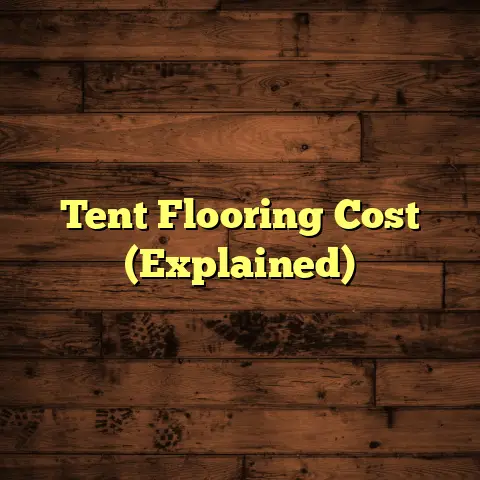Vinyl Flooring on Stairs: How-To (5 Key Steps)
They jump right in, thinking it’s a simple process,
but without proper preparation and measurement,
you’re setting yourself up for a world of frustration.
Uneven surfaces, potential safety hazards, and a
less-than-professional finish are just a few of
the potential pitfalls.
Trust me, I’ve seen it happen
time and time again.
That’s why I’m here to guide you through the
process, step by step.
Taking the time to prepare
correctly is crucial.
It’s the foundation for a
successful installation and a staircase you can
be proud of.
So, let’s dive in!
Section 1: Understanding Vinyl Flooring
What is Vinyl Flooring?
Vinyl flooring has come a long way, baby!
It’s no
longer your grandma’s linoleum.
Today, it’s a
durable, versatile, and stylish option for homes.
Vinyl flooring is a synthetic flooring made primarily
from polyvinyl chloride (PVC).
It comes in various
forms, each with unique characteristics:
Luxury Vinyl Planks (LVP): These mimic the look of hardwood, offering realistic wood grain patterns and textures.
They’re thicker and more durable than traditional vinyl.-
Luxury Vinyl Tile (LVT): Similar to LVP, but designed to resemble ceramic tile or stone.
-
Vinyl Sheets: Large rolls of vinyl flooring, often used in bathrooms and kitchens due to their water resistance.
-
Vinyl Tile: Individual tiles, typically square or rectangular, that can be arranged in various patterns.
The advantages of using vinyl flooring are numerous.
It’s durable, easy to maintain, and aesthetically
appealing.
Plus, it’s more water-resistant than
laminate and often more budget-friendly than
hardwood.
Why Choose Vinyl for Stairs?
So, why choose vinyl specifically for your stairs?
Well, let me break it down for you:
Slip Resistance: Many vinyl options have textured surfaces that provide excellent grip, reducing the risk of slips and falls.
This is especially important on stairs, where safety is paramount.Variety of Styles: Vinyl comes in a wide range of colors, patterns, and textures.
Whether you want a classic wood look, a modern tile design, or something completely unique, you’re sure to find a vinyl option that suits your style.Cost-Effectiveness: Compared to hardwood or tile, vinyl is a budget-friendly option.
You can achieve a high-end look without breaking the bank.Durability: Stairs are high-traffic areas, so you need a flooring material that can withstand wear and tear.
Vinyl is known for its durability and resistance to scratches, dents, and stains.Easy Maintenance: Vinyl is easy to clean and maintain.
A simple sweep or mop is usually all it takes to keep it looking its best.
According to a recent report by MarketWatch, the global vinyl flooring market is expected to reach \$48.98 billion by 2028, driven by its durability and versatility. (Source: MarketWatch)
Section 2: Tools and Materials Needed
Alright, now that we’ve covered the basics of vinyl
flooring, let’s talk about the tools and materials
you’ll need for this project.
Having the right tools
will make the job much easier and ensure a professional
finish.
Here’s a comprehensive list:
Measuring Tape: Essential for accurate measurements of your stairs.
I recommend a tape measure that’s at least 25 feet long.Utility Knife: For cutting the vinyl flooring.
Make sure you have plenty of sharp blades on hand.
A dull blade can tear the vinyl and make it difficult to achieve clean cuts.-
Straight Edge: A metal ruler or level will help you make straight, precise cuts.
Trowel or Roller for Adhesive: Depending on the type of adhesive you’re using, you’ll need a trowel or roller to apply it evenly.
Check the adhesive manufacturer’s instructions for recommendations.Safety Equipment: Safety first!
Wear gloves to protect your hands from adhesive and sharp edges.
Knee pads will make the job much more comfortable, especially if you’re working on multiple stairs.
Eye protection is also a good idea.-
Pencil or Marker: For marking cut lines on the vinyl flooring.
-
Scissors: For trimming small pieces of vinyl or making intricate cuts.
-
Hammer and Nail Set (if needed): If you need to repair any loose boards on your stairs, you’ll need a hammer and nail set.
-
Vacuum Cleaner: For cleaning the stairs before and after installation.
-
Putty Knife: For scraping away old adhesive or debris.
-
Level: To ensure your stairs are level before you begin installation.
Now, let’s talk about the vinyl flooring itself.
Not all vinyl is created equal, and some types are
better suited for stairs than others.
I recommend using either Luxury Vinyl Planks (LVP)
or Luxury Vinyl Tile (LVT) for stairs.
These options
are typically thicker and more durable than vinyl
sheets or traditional vinyl tiles.
Here are a few specific products that I’ve had success with in the past:
Armstrong Luxe Plank with Rigid Core: This LVP is waterproof, scratch-resistant, and easy to install.
It also comes in a wide range of styles.Shaw Floorté Pro Series: This LVP is another excellent option.
It’s known for its durability and realistic wood look.-
Coretec Plus: This LVT is a popular choice for its waterproof construction and comfortable feel underfoot.
Pro Tip: When choosing vinyl flooring for stairs,
look for options with a high wear layer.
The wear
layer is the protective coating on the surface of
the vinyl that resists scratches and stains.
A wear
layer of 20 mil or higher is recommended for high-traffic
areas like stairs.
Section 3: Preparing the Staircase
Okay, we’ve got our tools and materials.
Now it’s
time to prepare the staircase.
This is a crucial
step, so don’t skip it!
Proper preparation will
ensure that your vinyl flooring adheres properly
and looks its best.
Step 1: Measure Your Stairs
Accurate measurements are essential for a successful
installation.
You’ll need to measure each stair
tread (the horizontal part you step on) and riser
(the vertical part between the treads).
Here’s how to do it:
Measure the Tread: Measure the width and depth of each tread.
Be sure to measure at the widest point, as stairs are not always perfectly square.Measure the Riser: Measure the width and height of each riser.
Again, measure at the widest point.Consider the Nosing: The nosing is the overhanging edge of the tread.
If your stairs have a nosing, you’ll need to account for it when cutting your vinyl flooring.
You can either wrap the vinyl around the nosing or install a separate stair nosing.
Pro Tip: Stairs are rarely uniform.
Measure each
tread and riser individually.
Don’t assume that
they’re all the same size.
Label each measurement
so you know which piece of vinyl goes where.
Step 2: Clean and Repair the Surface
Once you’ve got your measurements, it’s time to clean and repair the stairs.
Remove Old Flooring: If your stairs have existing flooring, such as carpet or tile, you’ll need to remove it.
Use a utility knife and pry bar to remove the old flooring carefully.Clean the Stairs: Use a vacuum cleaner to remove any debris, dust, or dirt from the stairs.
Then, use a damp cloth and mild detergent to clean the surface thoroughly.-
Assess for Damage: Inspect the stairs for any damage, such as cracks, loose boards, or uneven surfaces.
Repair Damage: If you find any damage, you’ll need to repair it before installing the vinyl flooring.
-
Cracks: Fill any cracks with wood filler and let it dry completely.
Then, sand the filler smooth. -
Loose Boards: Secure any loose boards with nails or screws.
Use a nail set to countersink the nails. -
Uneven Surfaces: Use a self-leveling compound to create a smooth, even surface.
Follow the manufacturer’s instructions carefully.
-
According to the National Safety Council, more
than one million Americans seek medical attention
for slip-and-fall injuries each year.
Proper stair
preparation can significantly reduce the risk of
these accidents.
(Source: National Safety Council)
Section 4: Installing Vinyl Flooring on Stairs
Alright, we’ve prepped our stairs.
Now for the
fun part – installing the vinyl flooring!
Step 3: Cut the Vinyl to Size
Careful cutting is key to a professional-looking installation.
Transfer Measurements: Transfer your measurements to the vinyl flooring.
Use a pencil or marker to draw cut lines on the back of the vinyl.Cut the Vinyl: Use a utility knife and straight edge to cut the vinyl along the cut lines.
Score the vinyl several times before cutting all the way through.
This will help you achieve a clean, precise cut.Test Fit: Before applying adhesive, test fit the vinyl pieces on the stairs.
Make sure they fit snugly and that the edges are aligned.
Pro Tip: Cut the vinyl slightly larger than the
actual measurements.
You can always trim off any
excess vinyl later.
It’s better to have too much
than not enough.
Step 4: Apply Adhesive
Choosing the right adhesive and applying it correctly is crucial for proper adhesion.
Choose the Right Adhesive: Select an adhesive that is specifically designed for vinyl flooring.
Check the adhesive manufacturer’s instructions for recommendations.Apply Adhesive: Use a trowel or roller to apply the adhesive evenly to the stair treads and risers.
Follow the adhesive manufacturer’s instructions for the recommended spread rate.Working Time: Pay attention to the adhesive’s “open time” or “working time”.
This is the amount of time you have to position the vinyl flooring before the adhesive starts to set.
Pro Tip: Work in small sections.
Apply adhesive
to one or two stairs at a time.
This will prevent
the adhesive from drying out before you have a chance
to position the vinyl flooring.
Step 5: Position and Secure the Vinyl
This is where your patience and attention to detail will really pay off.
-
Position the Vinyl: Carefully position the cut vinyl pieces on the stairs, ensuring they fit snugly.
Press Down: Press down firmly on the vinyl, working from the center outwards.
This will help to remove any air bubbles and ensure that the vinyl is properly adhered to the stairs.Roll the Surface: Use a flooring roller to roll over the surface of the vinyl.
This will help to create a strong bond between the vinyl and the adhesive.-
Clean Up Excess Adhesive: Use a damp cloth to wipe away any excess adhesive that squeezes out from the edges of the vinyl.
Pro Tip: Use a J-roller to get into corners and
along edges.
This tool helps to ensure that the
vinyl is properly adhered in these hard-to-reach
areas.
Section 5: Finishing Touches
Almost there!
Now it’s time for the finishing touches
that will give your stairs a professional look.
Trim Excess Vinyl: Use a utility knife to trim any excess vinyl around the edges of the stairs.
Be careful not to damage the surrounding surfaces.Install Stair Nosing: If you’re not wrapping the vinyl around the nosing, you’ll need to install a separate stair nosing.
Stair nosings are available in a variety of materials, including vinyl, wood, and metal.Caulk the Edges: Apply a bead of caulk along the edges of the vinyl flooring where it meets the wall or baseboard.
This will help to seal the edges and prevent moisture from getting underneath the vinyl.
According to the Consumer Product Safety
Commission (CPSC), stair-related injuries account
for more than one million emergency room visits
each year in the United States.
Proper stair
nosing can significantly reduce the risk of these
injuries.
(Source: Consumer Product Safety Commission)
Conclusion
Installing vinyl flooring on stairs can be a rewarding
DIY project.
But it’s important to take the time to
plan and execute each step carefully.
Proper
measurement, preparation, and installation techniques
are essential for achieving a beautiful and safe
finished product.
Remember, I’ve seen firsthand what happens when
homeowners rush the process or skip important steps.
Don’t let that be you!
Take your time, follow these
steps, and you’ll be amazed at the results.
Call to Action
Now I’d love to hear from you!
Have you ever
installed vinyl flooring on stairs?
What challenges
did you face?
Do you have any tips or tricks to
share?
Leave a comment below and let’s start a
conversation!
And if you have any questions, don’t
hesitate to ask.
I’m here to help!





